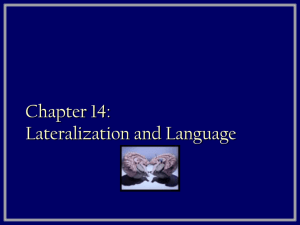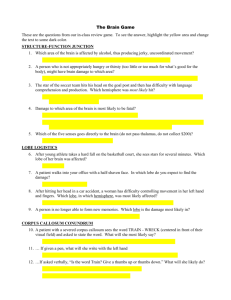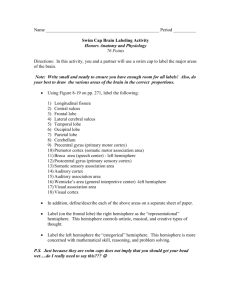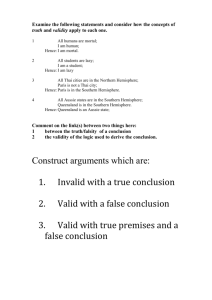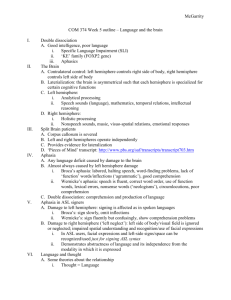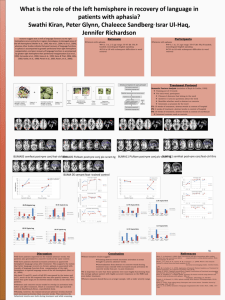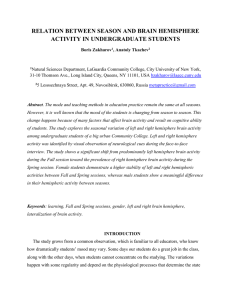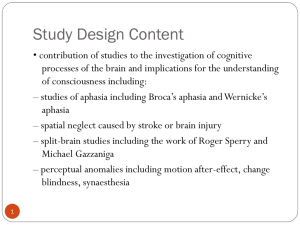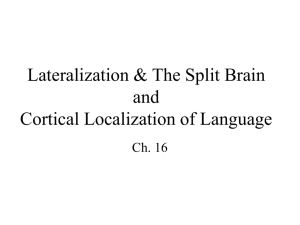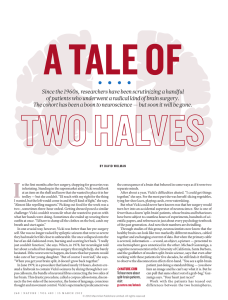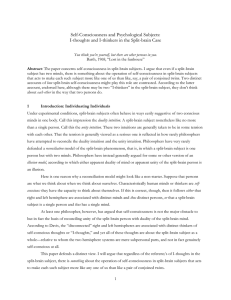Cognitive Process and brain structure
advertisement
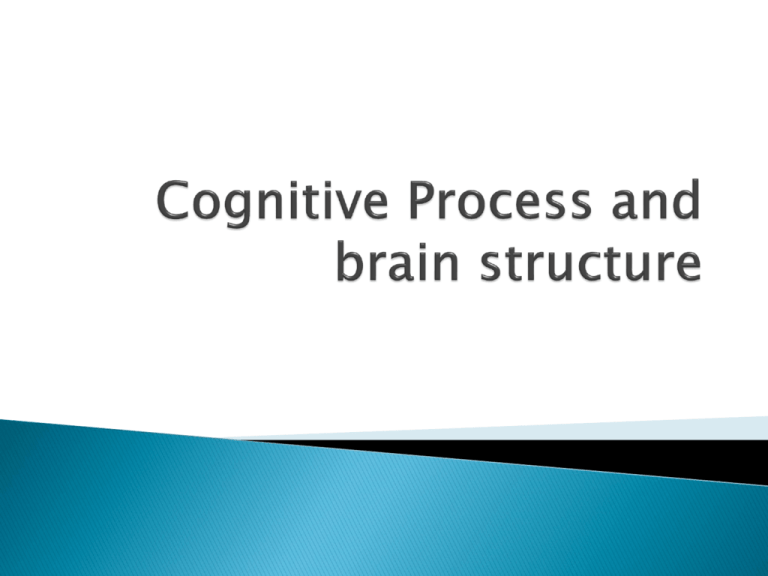
Hemispheric Specialisation Contribution of studies to the investigation of cognitive processes of the brain and implications for the understanding of consciousness including: studies of aphasia (Broca’s and Wernicke’s) Spatial Neglect caused by stroke or brain injury Split-brain studies including work of Roger Sperry & Michael Gazzaniga Hemispheric Specialisation/hemispheric dominance or hemispheric lateralisation. Two hemispheres appear replicas in size, shape and certain functions. Some functions are ‘contralateralised’. The somatosensory cortex of Right parietal lobe receives information from Left side of body. The primary motor cortex in Right parietal lobe controls movement of Left side of body Evidence about HS from people with brain damage. Damage to Left Hemisphere result in language-related difficulties. Damage to Right Hemisphere – difficulties with visual and spatial tasks Verbal Functions: word recognition – reading, writing, speaking, understanding speech. Analytical Functions: sequential, step-bystep task completion, logical reasoning, interpreting and solving maths problem, critically evaluating, developing an argument, time management Receives and processes sensations from R side of body Controls voluntary movement of R side of body Non-verbal Functions: spatial and visual thinking e.g. doing a jigsaw puzzle, reading a map, visualising objects in space, Recognising faces, patterns, tunes Music appreciation Creative thinking, daydreaming Sensations from L side of body and motor control of L side of body Aphasia – refers to a language disorder apparent in speech (comprehension or production), writing or reading produced by injury to brain areas specialised for these functions. Broca’s Aphasia & Wernicke’s Aphasia Most common cause – stroke. Damage to area in Left frontal lobe (next to motor cortex). speech is non-fluent with pauses between words, short sentences mainly verbs & nouns. Words may be mispronounced. Partial/complete loss of memory for finding correct word Can be confused if change order of words in sentence. E.g. I broke the vase to The vase was broken by me. Aware of their difficulties. Deaf people with Broca’s aphasia have difficulty producing sign language. Damage to Left Hemisphere – Temporal Lobe Can produce fluent speech but generally nonsensical Difficulty understanding speech & written language Impaired ability to recall words. Some can ‘sing’ sentences and make sense (RH- musical) Generally not aware of their difficulties. An attentional disorder in which individuals fail to notice anything either on their left or right (not as common) side. Failure of attention and not a disorder due to impairment of memory, the visual system or other sensory systems. Most common in stroke/accident victims – extensive damage to rear of parietal lobe of Right Hemisphere Side of world opposite to (contralateral) damaged hemisphere tends to be neglected. Involves surgically cutting the corpus callosum hence disconnecting one hemisphere from the other. Originally conducted to treat epilepsy 1950s Roger Sperry – study with cats’ visual system Each eye normally sends visual information to both hemispheres via the optic nerve and optic chiasm. Cutting this means that visual information to left eye is sent only to left hemisphere etc. (Textbook pg. 224) Nelson Psychology VCE Units 3 & 4: Teacher Resource CD 9780170185219 Gazzaniga – designed series of experiments to test split-brain patients. Check YouTube – Gazzaniga and split-brain experiments Nelson Psychology VCE Units 3 & 4: Teacher Resource CD 9780170185219 If information flashed on Left Visual Field – goes to Right Hemisphere. Individual cannot SAY what they have seen but can draw it with Left hand. (the right hemisphere is nonverbal). The visual information sent to the right hemisphere cannot cross back to left hemisphere because corpus callosum is cut, then unable to say what they saw. If information from Right Visual Field goes to Left Hemisphere individual can say what object is. Pretend to be a Split-brain patient. The experiment, the patient, the recorder Patient closes their eyes. Experimenter places an item in the patient’s right hand. Can the patient identify the item by name? Why? Experimenter places a different item in the patient’s left hand. Can the slit-brain patient name the object? Why? Experimenter writes the name of an item on a piece of paper and flashes this to Left Visual Field of the patient. From an array of different items, can the patient select the right item? Why? Experimenter now flashes name of an item in the Right Visual Field. Can the patient now select the correct item from an display of items? Why? Is she likely to say that she saw an object? Give reason. Is she able to verbally identify the object? Give reason Is she able to identify the object with her left hand by touch (selecting the item from behind the screen)? Reasons Is she able to identify the object with her right hand by touch (selecting the item from behind the screen)? reasons Is she likely to say that she saw an object? Give reasons Is she able to verbally identify the object? Give reasons Is she able to identify the object with her left hand by touch (selecting the item from behind the screen)? Give reasons Is she able to identify the object with her right hand by touch (selecting the item from behind the screen)? Give reasons
